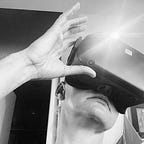Why VR Needs to Designed for the Least Technical Person in the Room
First, a little story. Three years ago, when I was working at a VR production company, two men came by to demo a platform they were building. I hopped in the Vive and one of them immediately started barking instructions at me: “click the trigger! Now teleport over there! No, over there! Now use the button to scroll up! No, the other button!” Finally, I took the headset off out of sheer frustration and exhaustion, only to have one of them ask me if I even knew how to use VR at all.
I did, of course, and that’s the point. If a VR professional can’t figure out your experience without you barking instructions at them, how in the world is a normal person, who will presumably be using the experience without you standing over them, ever be able to do it?
We talk a lot about the things that are holding VR back, but one of the biggest issues that doesn’t ever seem to be addressed is the lack of VR designed for non-technical people, especially in the training space. Many VR training simulations require controllers even when the outcome could be accomplished without using them at all. For example, I recently saw a piece that put a user in a scary situation, then had them use the clicker to take a quiz to select their next step. First off, this breaks the immersion and is completely unrealistic, but beyond that, it just introduces another complexity and increases the chance that something will go wrong and they’ll get flustered and turned off.
Using a remote to click on something, except for a TV, is not an intuitive user behavior. That’s the reason that when my agency designs training experiences, we use intuitive behaviors like voice and gaze to drive the action. After all, you don’t talk to someone by clicking a remote at them, you talking to them by…talking to them.
When training for soft skills, the challenges are easier to solve; when training for hard skills, which require people to use their hands and move around, it becomes much more difficult. Leap Motion could have been a great solution for this, but the company’s recent fire sale doesn’t bode well for its future. The HaptX glove is fantastic but still too big to be widely deployed, although I imagine it will slim down as it develops. Haptic suits like the Teslasuit are interesting but can be very buggy, not to mention cost prohibitive.
The best solutions we’ve found include:
Using haptic trackers to make sure movements are being performed correctly. We worked on a piece where employees had to train to safely lift boxes, and they mirrored the movements on someone in VR. We were able to track the movements and make sure they were doing it correctly and were prompted by the buzz of a haptic device if they weren’t.
Blending the real and virtual world. This involves using either a mixed reality headset like a Magic Leap or Hololens and building a physical world to complete the simulation. While more expensive initially, if you are training people in dangerous jobs, the cost/benefit of this rapidly becomes clear. Haptics can also be incorporated to guide a user when they are making mistakes. New “pass through” devices that work with VR headsets are coming to the market, which should help blend physical and digital worlds more seamlessly and cut down on the cost of buying new headsets.
Flipping the script and having the trainee become the trainer. An employee can use voice prompts to walk someone through a situation and ideally can see them do it correctly, but also learn the steps for themselves. In this case, the experience is also an empowering lesson because the user is being seen as a teacher and an expert, which could potentially make them more comfortable mentoring other colleagues.
No matter which direction a company chooses to go, the core design principle has to remain the same — the experience has to be easy enough for the least technical person in the room to use. There have been a lot of proud moments for me as I show our Accenture AvenueS piece to people, but nothing made me happier than seeing my parents, who are not technical AT ALL, go through the experience with ease and comfort.
The design of the VR headset has improved exponentially over the course of the last few years, and for that I am grateful. It’s now time to start re-thinking the methods we use to interact with those headsets. If we don’t spend time thinking about the best ways to make sure everyone can be included in and use VR, then the industry’s path ahead will be an arduous one.
